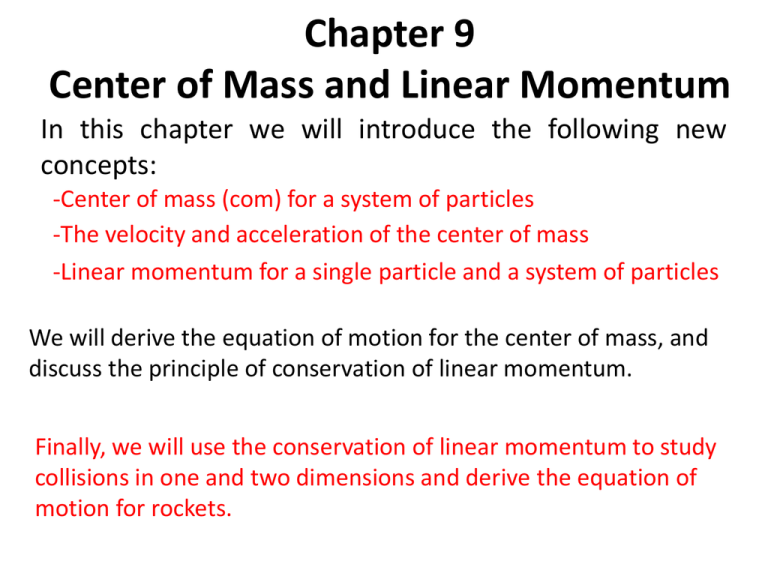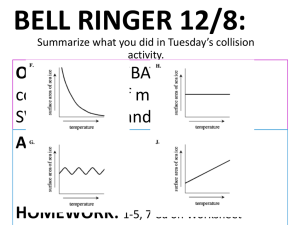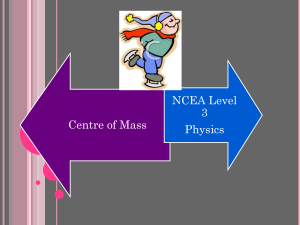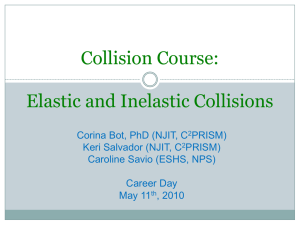Chapter 9 - Learning
advertisement

Chapter 9 Center of Mass and Linear Momentum In this chapter we will introduce the following new concepts: -Center of mass (com) for a system of particles -The velocity and acceleration of the center of mass -Linear momentum for a single particle and a system of particles We will derive the equation of motion for the center of mass, and discuss the principle of conservation of linear momentum. Finally, we will use the conservation of linear momentum to study collisions in one and two dimensions and derive the equation of motion for rockets. What is the centre of mass of an object? Consider a bat thrown into the air. If you look closely, you will find that one special point of the bat moves in a simple parabolic path, just as a particle would if tossed into the air. That special point moves as though (1) the bat's total mass were concentrated there and (2) the gravitational force on the bat acted only there. That special point is said to be the center of mass of the bat. In general: DEFINITION of CENTRE OF MASS The center of mass of a body or a system of bodies is the point that moves as though all of the mass were concentrated there and all external forces were applied there. Centre of Mass (com) • Fig. 9-2a shows two particles with masses m1 and m2 that are a distance d apart. • The origin of the x-axis is chosen as the position of m1. • The position of the centre of mass (com) of this twosystem is then defined as: xcom m2 d m1 m2 (9-1) Fig.9-2b • Two particles with masses m1 and m2 , have positions x1 and x2 respectively , and are a distance d apart. • The centre of mass is now defined as: xcom m1 x1 m2 x2 m1 m2 Substitute m1 + m2 = M (sum total of masses of two particles) xcom m1 x1 m2 x2 M (9-3) (9-2) Centre of Mass of a system of particles • If there are n particles in a system, stretched out along the x-axis, then: • M = m1 + m2 + .... + mn, and • The position of the centre of mass is: 1 n m1 x1 m2 x2 .... mn xn mi xi (9-4) xcom M i 1 M • If the particles are spread out in three dimensions, the centre of mass must be defined by three position coordinates: 1 n 1 n 1 n xcom mi xi ; ycom mi yi ; zcom mi zi (9-5) M i 1 M i 1 M i 1 Solid uniform objects • An ordinary object like a baseball bat, consist of so many particles (atoms) that it can be considered as a continuous distribution of matter. • Each particle is then a differential mass element dm, • And the sums of eq. 9-5 become integrals and the coordinates of the centre of mass are defined as: xcom 1 M xdm ; ycom 1 M ydm ; with M the mass of the object. zcom 1 M zdm; (9-9) • It is very difficult to determine these integrals, but uniform objects have uniform densities, mass per volume, thus dm M (9-10) • Density = mass / volume: • Then : M dm dV V • And substitute into eq. 9-9 then: xcom Also And 1 1 M x dV M V V xdV 1 ycom ydV V 1 zcom zdV V dV V • If an object has a point, a line or plane of symmetry, then the centre of mass of the object lies at that point, on the line or in the plane of symmetry. • It can also happen that the centre of mass lies outside of the object, e.g. a horseshoe and a doughnut. Centre of Mass Centre of Mass “ Sample Problem” 9-1 on p. 204(204)(171) in H&R. • Fig. 9-3 Three particles form an equilateral triangle with each side = a. • The Centre of Mass is found by the position vector rcom. Particle 1 2 3 Mass (kg) 1.2 2.5 3.4 x (cm) y (cm) 0 140 70 0 0 120 • M = 1.2 + 2.5 + 3.4 = 7.1 kg • x-coordinate: xcom m1 x1 m2 x2 m3 x3 M (1.2kg)(0) (2.5kg)(140cm) (3.4kg)(70cm) xcom = 83 cm 7.1kg And also ycom = 58 cm Thus position vector: r com = xcom î + ycomĵ = (83 î + 58 ĵ ) cm Calculate the value and position of rcom like any other vector. rcom= 101.26 cm and 35˚ with the positive x-axis Newton’s Second Law for a System of Particles • If you roll a cue ball at a second billiard ball that is at rest, you expect that the two-ball system will continue to have some forward motion after impact. • What continues to move forward, in a steady motion completely unaffected by the collision, is the centre of mass of the two-ball system. • We replace the pair of billiard balls with an assemblage of n particles of (possibly) different masses. We are interested not in the individual motions of these particles but only in the motion of their center of mass. • Although the center of mass is just a point, it moves like a particle whose mass is equal to the total mass of the system; • we can assign a position, a velocity, and an acceleration to it. • The vector equation that describes the motion of the centre of mass of such a system of particles, is then: Fnet = Manet (9-14) • This equation is Newton’s second law for the motion of the centre of mass of a system of particles. • It looks like the equation applicable to the motion of a single particle F = ma. NB: 1. Fnet is the net force of all external forces that act on the system. 2. M is the total mass of the system. We assume that no mass enters or leaves the system as it moves, so that M remains constant. The system is said to be closed. 3. acom is the acceleration of the centre of mass of the system. 4. Because acom can consists of x-, y- and z-components, we thus have: (9-15) • Now we again examine the behaviour of the billiard balls. • Once the cue ball has begun to roll, no net external force acts on the (two-ball) system. • Thus Fnet = 0, and acom = 0 . • Acceleration = the rate of change in velocity, • thus the velocity of the centre of mass does not change. • When the two balls collide, the forces that come into play are internal forces so they do not contribute to the net force Fnet, which remains zero. • Thus, the center of mass of the system, which was moving forward before the collision, must continue to move forward after the collision, with the same speed and in the same direction. Proof of eq.9-14 n • Eq.9-8 : rcom 1 M mi ri , i 1 • Thus Mrcom m1r1 m2 r2 .... mn rn , (9-16) • Differentiate eq.9-16 with respect to time: drcom M Mvcom m1v1 m2 v2 m3v3 ... mn vn dt (9-17) • Differentiate eq.9-17 with respect to time: dvcom M Macom m1a1 m2 a2 m3 a3 ... mn an dt (9-18) But from Newton II, Fnet = ma or Fi = miai, Thus Ma F F F .... F 1 Macom Fnet com 2 3 n (9-19) (9-14) Sample Problem 9-3, p.208 Linear Momentum • The linear momentum of a particle with mass m and velocity v is defined as a vector p, • p = mv • With p and v in the same direction. • SI unit: kilogram-meter per second or kg.m/s. • Newton’ s Second Law of motion in terms of momentum: • The time rate of change of the momentum of a particle is equal to the net force acting on the particle and is in the direction of that force. • In equation form: Fnet dp dt (9-23) • The linear momentum of an object can only be changed by a net external force! dp Substitute p mv into Fnet dt Then F dp d (mv ) m dv ma net dt dt dt The Linear Momentum of a System of Particles • For a system of n particles, each with its own mass, velocity, and linear momentum interacting with each other, the system as a whole has a total linear momentum P, which is defined to be the vector sum of the individual particles' linear momentum. (9-24) If we compare this equation with Eq. 9-17 , we see that (9-25) • This gives us another way to define the linear momentum of a system of particles: • The linear momentum of a system of particles is equal to the product of the total mass M of the system and the velocity of the center of mass. • Differentiating eq.9-25 with respect to time gives: dvcom dP M Macom (9-26) dt dt • Comparing Fnet = Ma , eq.9-14, with eq.9-26, net then: dP (system of particles) Fnet (9-27) dt Collision and Impulse • The momentum, p, of any particle cannot change unless a net external force, Fnet acts on it. • Two ways to change p: - push or throw object; - collision with another object • In a collision (crash), - the external force is brief - has large magnitude - suddenly changes object’s p. • In a collision where one object moves and the other is stationary, the moving object is called the projectile and the stationary object the target. Single Collision • Let projectile = a ball and target = a bat • Collision is brief, but force on ball big enough to slow, stop or even reverse its motion. • So from eq.9-27, dp = F(t)dt (9-28) • Find the net change in ball’s momentum by integrating both sides from time ti just before collision to time tf just after collision: • t t dp F (t )dt (9-29) • left side: • right side: f f ti ti pf – pi = Δp impulse = J tf tf dp F (t )dt ti (9-29) ti tf J F (t ) dt Impulse defined ti p J Linear momentum-Impulse theorem (9-30) (9-31) In vector form: p f pi J (9-32) In component form: px J x (9-33) p fx pix Fx dt (9-34) tf And ti • Often we do not know how the force varies with time, but we know the magnitude of the average force, Favg, and the duration Δt (= tf – ti) of the collision. • Then the magnitude of the impulse is: J = FavgΔt (9-35) • • • • • What if instead we focused on the bat? According to Newton III: Fball = -Fbat Same magnitude, but opposite directions Thus from eq.9-35: Jball = -Jbat Do Sample Problems 9-4 & 9-5, p213-214 A series of Collisions • Now let's consider the force on a body when it undergoes a series of identical, repeated collisions. • For example, as a prank, we might adjust one of those machines that fires tennis balls to fire them at a rapid rate directly at a wall. • Each collision would produce a force on the wall, but that is not the force we are seeking. We want the average force Favg on the wall during the bombardment—that is, the average force during a large number of collisions. Fig.9-10 A steady stream of projectiles, with identical linear momenta, collides with a target, which is fixed in place. The average force Favg on the target is to the right and has a magnitude that depends on the rate at which the projectiles collide or, equivalently, the rate at which mass collides. • Each projectile has initial momentum mv and undergoes a change p in linear momentum because of the collision. The total change in linear momentum for n projectiles during interval t is n p. The resulting impulse J on the target during t is along the x axis and has the same magnitude of n p but is in the opposite direction. • We can write this relation in component form as: J = -np (9-36) where the (–) sign indicates that J and p have opposite directions. • By rearranging, the average force Favg , acting on the target during the collisions is: J n n Favg p mv (9-37) t t t • This equation gives Favg i.t.o. n/t, the rate at which the projectiles collide against the target, and v the change in the velocity of the projectiles. Conservation of Linear Momentum • Assume that the net external force on a system of particles is zero (an isolated system) and that no particles leave or enter the system (the system is closed). • If Fnet = 0 is substituted into Eq. 9-23, then dP/ dt = 0 • P = constant (closed, isolated system) (9-42) • In words: If no external force act on a system of particles, the total linear momentum of the system does not change. • Known as: Law of Conservation of Linear Momentum: – Pi = Pf (closed, isolated system) (9-43) – [Tot. Lin. momentum at a initial time ti ] = [Tot. Lin. momentum at a later time tf ] • Eq’s. 9-42 and 9-43 are vector equations and thus equivalent to three equations that correspond with the conservation of linear momentum in the three directions of the xyz –axis system. • Depending on the forces that act on the system, linear momentum can be conserved in one or two directions, but not necessarily in all directions. • If the component of the net external force on a closed system is zero along an axis, then the component of linear momentum on the system along the axis cannot change. • Do Sample Problems 9-6 to 9-8, p215-217 Momentum vs Kinetic Energy in Collisions • Consider a closed, isolated system of 2 particles: • P = constant, if Fnet = 0 • Now consider the kinetic energy of the 2 particles that collide: • If the total kinetic energy, Ktot , before and after a collision remains the same, then it is a elastic collision. • Often K is lost and transformed into other forms of energy during a collision, ex. thermal energy or sound energy, then it is an inelastic collision. • The biggest loss in K takes place during a collision where after the objects stick together, and is called a completely inelastic collision. • During a collision in a closed, isolated system, the momentum of individual bodies can change, but the total momentum P of the system cannot change, regardless if the collision was elastic or inelastic. • This is another way to express the Law of Conservation of Linear Momentum (discussed in Section 9-6). Inelastic Collision in One-Dimention Fig. 10-8 shows two bodies just before and just after they have a onedimensional collision (meaning that the motions before and after the collision are along a single axis). The velocities before the collision (subscript i) and after the collision (subscript f) are indicated. • The two bodies form our system, which is closed and isolated. We can write the law of conservation of linear momentum for this two-body system as: [total momentum Pi before collision] = [total momentum Pf after collision] • in symbol form: p1 i + p2 i = p1 f + p2 f (conservation of momentum) (9-50) Inelastic Collision in One-Dimention • Because the motion is one-dimensional, we can drop the overhead arrows for vectors and use only components along the axis. Thus, from p = mv, we can rewrite Eq. 9-50 as • m1v1 i + m2v2 i = m1v1 f + m2v2 f (9-51) • With this we can calculate one of the unknown values if the others were given. Completely Inelastic Collision Fig. 9-15 Before the collision m2 (target) is in rest and m1 (projectile) moves to the right. After the collision both the twee saam met dieselfde snelheid V. • For this case Eq. 9-51 becomes m1v1 i = (m1 + m2)V m1 • Or V v1i m1 m2 • V can thus be calculated from this. • Note that V must be smaller than v1i . (9-52) (9-53) Velocity of Centre of Mass • In a closed, isolated system, the velocity vcom of the centre of mass of the system cannot be changed by a collision because, with the system isolated, there is no net external force to change it. • To get an expression for vcom, let us return to the two-body system and one-dimensional collision of Fig. 9-15 . From Eq. 9-25 (P = Mvcom), we can relate vcom to the total linear momentum P of that twobody system by writing P Mvcom (m1 m2 )vcom P p1i p2i (9-54) (9-55) Velocity of Centre of Mass • If P is replaced by Eq.9-55 in Eq.9-54 and then solved for vcom , we get: P p1i p2i vcom (9-56) m1 m2 m1 m2 • The right side of this equation is a constant, and vcom has that same constant value before and after the collision. NB: Sample Problem 9-9, p219-220 Principle of function of ballistic pendulum Vbullet&block vbullet mbullet vbullet mbullet mblock mbullet&block Vbullet&block mbullet From the conservation of mechanical energy: 1 2 mbullet&blockV mbullet&block gh 2 V 2gh vbullet mbullet&block mbullet 2 gh (0.0095 5.4)kg 2 vbullet 2(9.8m / s )(0.063m) 630m / s 0.0095kg Elastic Collision in One-dimention • Ktot before collision = Ktot after collision • In an elastic collision, the kinetic energy of each colliding particle can change, but the total kinetic energy of the system does not change. • Thus ex. For a stationary target: m1v1i = m1v1f + m2v2f (lin.momentum) (9-63) • and ½m1v1i2 = ½m1v1f2 + ½m2v2f2 (kin.energy) (9-64) • Thus from eq.9-63: m1(v1i - v1f )= m2v2f (9-65) • And from eq.9-64: m1v1i2 - m1v1f2 = m2v2f2 m1(v1i + v1f)(v1i - v1f) = m2v2f2 (9-66) • Divide eq.9-66 by 9-65 and with further algebra it follows that: and m1 m2 v1 f v1i m1 m2 2m1 v2 f v1i m1 m2 (9-67) (9-68) m1 m2 v1 f v1i m1 m2 2m1 v2 f v1i m1 m2 (9-67) (9-68) • Equal masses: m1 = m2 then v1f = 0 and v2f = v1i two bodies exchange velocities • Massive target: m2 >> m1 then v1f ≈ -v1i en v2f ≈ (2m1/m2)v1i (9-69) body 1 bounces back with almost the same speed, body 2 moves forward very slowly. m1 m2 v1 f v1i m1 m2 2m1 v2 f v1i m1 m2 (9-67) (9-68) • Massive projectile: m1 >> m2 then v1f ≈ v1i en v2f ≈ 2v1i (9-70) body 1 moves forward with almost the same speed, body 2 moves forward at double the speed of body 1. • Do Sample Problem 9-11, p223








